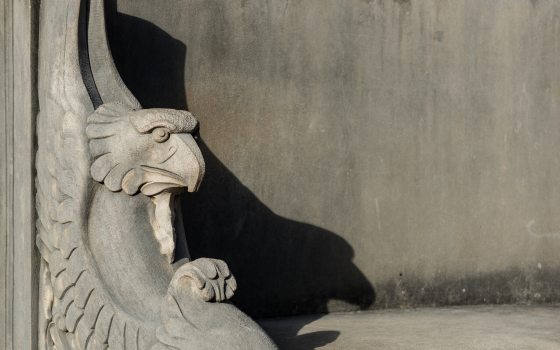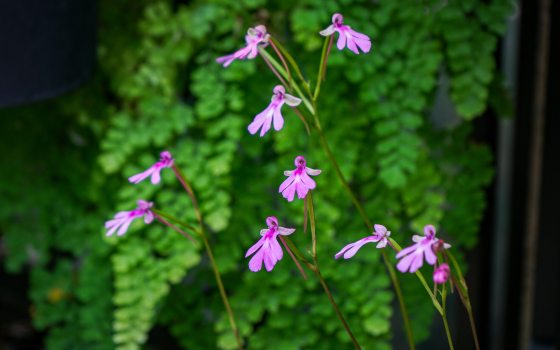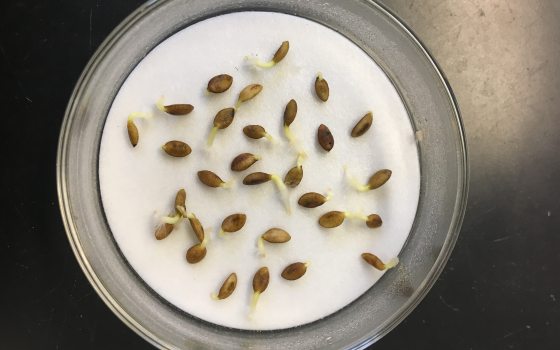For more than 110 years, Longwood guests have found delight in whispering a secret to a companion on our historic Whispering Bench, located at the eastern end of the colorful Flower Garden Walk, Longwood’s first garden. The limestone semi-circular bench can almost magically carry a whispered secret at full volume from someone seated at one end to another at the opposite end. This phenomenon, known as whispering-gallery waves, was first explained by British mathematician and physicist Lord Rayleigh in his 1878 book The Theory of Sound vol. 2, after visiting the Whispering Gallery in the dome of London’s St. Paul’s Cathedral to conduct observations. Today, our beloved Whispering Bench is not only a lovely place to sit and take in the view; it’s a place of physics, history, and curiosity, where secrets have been told—and fun has been had—for generations. Today—and in honor of National Physics Day—we’re delighted to tell its story.
Our founder Pierre S. du Pont designed and installed the Flower Garden Walk in 1907. He had purchased the historic property, which included the Peirce house, in 1906 and located the garden within view of the house. He described the bench he wished to include in a 1908 letter to stoneworkers The Leland Company: “I had also planned a bench at one end of the garden path, which bench was to be semi-circular in form, the circle being about ten or fifteen feet. The garden being of what is known as the ‘old fashioned’ type, this bench… would not be a very elaborate design.”
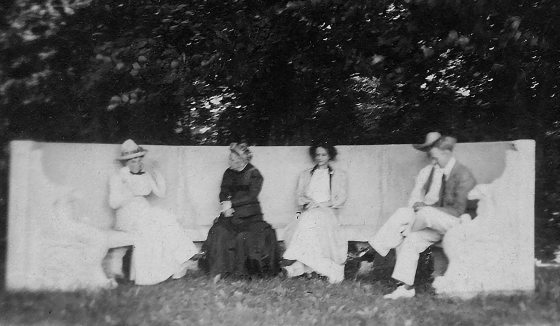
In this photo, Pierre du Pont (face hidden, in hat) and several family members are seen enjoying the stone bench in its location adjacent to Peirce’s Woods in the early years after its 1910 installation. Image courtesy of Hagley Museum and Library.
While it is not known if Pierre and his family had yet discovered the amazing acoustical powers of the bench when this photo was taken, his many visiting nieces and nephews whispered countless secrets into it over the years. Those nieces and nephews described Uncle Pierre as having a twinkle in his eye, always welcoming them to stay at Longwood where they could explore and have fun. The physics of the whispering-gallery waves would likely have been of interest to Mr. du Pont—a man of science (he earned a degree in chemistry from MIT) and eventual president of the DuPont company.
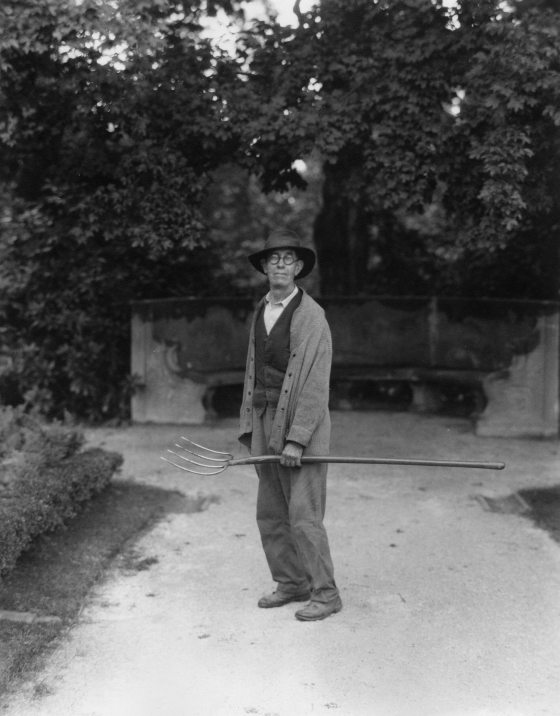
Gardener John Somners in front of the Whispering Bench in 1922. Image courtesy of Hagley Museum and Library.
Around the same time of the 1910 installation of the Whispering Bench at Longwood, Lord Rayleigh was further investigating sound waves across the Atlantic at St. Paul’s Cathedral. He had previously published in 1878 that the widely held belief that sound traveled by reflecting off the dome and across the diameter of the circular gallery was incorrect. It was in fact “creeping” around and clinging to the curved wall: “The abnormal loudness with which a whisper is heard is not confined to the position diametrically opposite to that occupied by the whisperer… The whisper seems to creep round the gallery horizontally, not necessarily along the shorter arc, but rather along that arc towards which the whisperer faces.” Rayleigh, wanting to revisit his research, then presented a mathematical formula for the sound waves in a 1910 article.
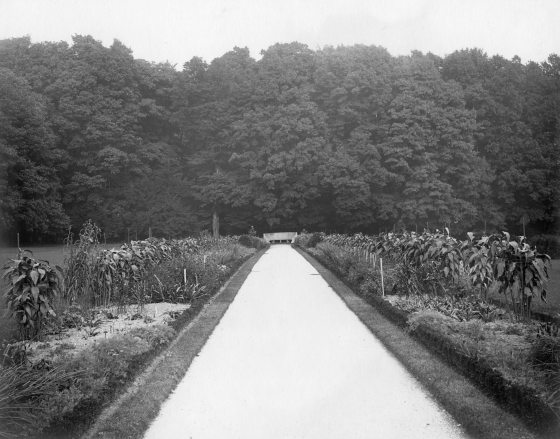
Whispering Bench at the end of the Flower Garden path in 1913. Image courtesy of Hagley Museum and Library.
There are many other monuments and buildings around the world with whispering galleries. The Temple of Heaven in Beijing, China has a circular wall around the Imperial Vault with whispering gallery waves. The Gol Gumbaz mausoleum in Bijapur, India has a dome with a whispering gallery similar to that in St. Paul’s cathedral. Grand Central Station in New York City has a whispering overhead diagonal arch on the lower level, in a tiled intersection near the Oyster Bar restaurant.
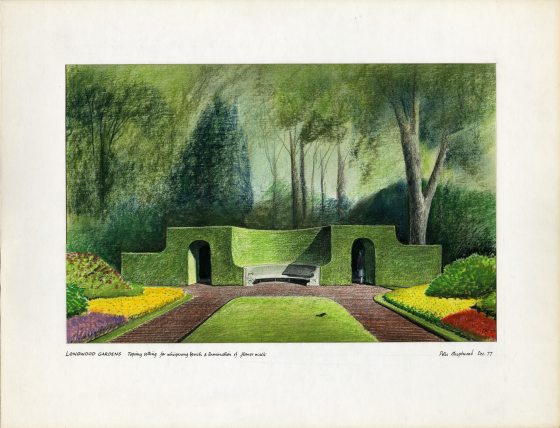
Sir Peter Shepheard’s 1977 design for “Topiary setting for whispering bench & termination of flower walk”.
The Whispering Bench stayed in place at the end of Flower Garden Walk until Longwood hired renowned landscape architect Sir Peter Shepheard to redesign the eastern end of the garden in 1977. Shepheard’s 2002 New York Times obituary states: “Sir Peter, who was knighted in 1980 for ‘services to architecture,’ emphasized the relationship between landscapes and man-made structures.” In a fitting example of this relationship, he proposed an architecturally pruned European hornbeam (Carpinus betulus) hedge as a green backdrop to the bench, and to include flanking tunnel entries into Peirce’s Woods. To provide some light behind the hedge, the bench was moved 35 feet west, away from the wooded area. The deteriorating original stone bench was also replaced with a limestone replica so that it might be enjoyed by Longwood guests long into the future.
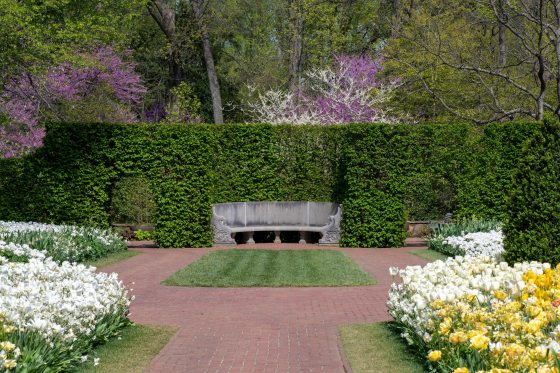
The Whispering Bench sits waiting amid the 2021 spring display. Photo by Hank Davis.
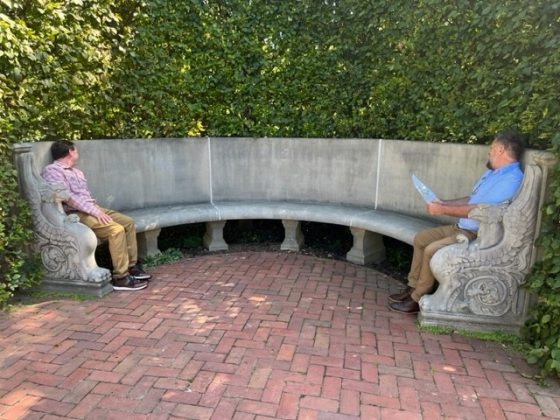
Generations of guests have tested the physics of the Whispering Bench. Photo by Paula Butera-Kunkel.
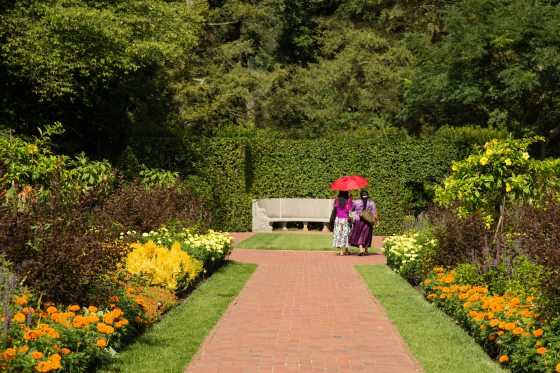
Guests stroll along a sunny Flower Garden Walk, towards the Whispering Bench, in this July 2015 shot. Photo by Carol DeGuiseppi.
The Whispering Bench is indeed a popular spot for guests of all ages. Longwood staff and volunteers often encourage guests to try the Whispering Bench, and many are amazed at the clarity of the whispered message received from their friend or family member seated at the other end. It works best when each person is seated in the corner, next to the carved griffin. They should face the back of the bench, and whisper into it for the sound to carry most effectively. There is another curved stone bench at the end of Paulownia Allee near the Visitor Center, but sound is not carried quite as effectively on this bench, perhaps because of the reduced angle of the curve.
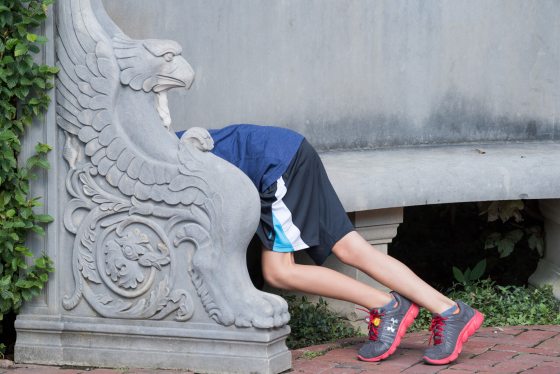
A young guest tests out the Whispering Bench. Photo by Hank Davis.
After strolling through the glorious seasonal blooms of the Flower Garden Walk, go ahead and try whispering a secret into Longwood’s Whispering Bench—it’s been listening for generations!
